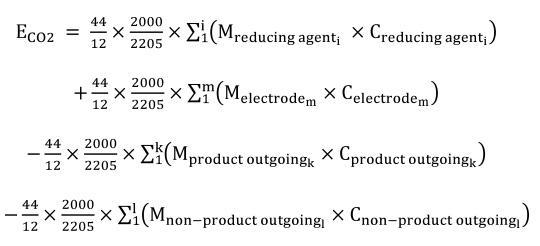['Air Programs']
['Greenhouse Gases']
09/24/2025
...
You must calculate and report the annual process CO 2 emissions from each calcium carbide process unit not subject to paragraph (c) of this section using the procedures in either paragraph (a) or (b) of this section.
(a) Calculate and report under this subpart the combined process and combustion CO 2 emissions by operating and maintaining CEMS according to the Tier 4 Calculation Methodology in §98.33(a)(4) and all associated requirements for Tier 4 in subpart C of this part.
(b) Calculate and report under this subpart the annual process CO 2 emissions from the calcium carbide process unit using the carbon mass balance procedure specified in paragraphs (b)(1) and (2) of this section.
(1) For each calcium carbide process unit, determine the annual mass of carbon in each carbon-containing input and output material for the calcium carbide process unit and estimate annual process CO 2 emissions from the calcium carbide process unit using equation 1 to this paragraph (b)(1). Carbon-containing input materials include carbon electrodes and carbonaceous reducing agents. If you document that a specific input or output material contributes less than 1 percent of the total carbon into or out of the process, you do not have to include the material in your calculation using equation 1.
Equation 1 to paragraph (b)(1)

Where:
E CO2 = Annual process CO 2 emissions from an individual calcium carbide process unit (metric tons).
44/12 = Ratio of molecular weights, CO 2 to carbon.
2000/2205 = Conversion factor to convert tons to metric tons.
M reducing agent = Annual mass of reducing agent i fed, charged, or otherwise introduced into the calcium carbide process unit (tons).
C reducing agent = Carbon content in reducing agent i (percent by weight, expressed as a decimal fraction).
M electrode = Annual mass of carbon electrode m consumed in the calcium carbide process unit (tons).
C electrode = Carbon content of the carbon electrode m (percent by weight, expressed as a decimal fraction).
M product outgoing = Annual mass of alloy product k tapped from the calcium carbide process unit (tons).
C product outgoing = Carbon content in alloy product k (percent by weight, expressed as a decimal fraction).
M non-product outgoing = Annual mass of non-product outgoing material l removed from the calcium carbide unit (tons).
C non-product outgoing = Carbon content in non-product outgoing material l (percent by weight, expressed as a decimal fraction).
(2) Determine the combined annual process CO 2 emissions from the calcium carbide process units at your facility using equation 2 to this paragraph (b)(2).
Equation 2 to paragraph (b)(2)
CO 2 = Σ1 k E CO2
Where:
CO 2 = Annual process CO 2 emissions from calcium carbide process units at a facility used for the production of calcium carbide (metric tons).
E CO2 = Annual process CO 2 emissions calculated from calcium carbide process unit k calculated using equation 1 to paragraph (b)(1) of this section (metric tons).
k = Total number of calcium carbide process units at facility.
(c) If all GHG emissions from a calcium carbide process unit are vented through the same stack as any combustion unit or process equipment that reports CO 2 emissions using a CEMS that complies with the Tier 4 Calculation Methodology in subpart C of this part, then the calculation methodology in paragraph (b) of this section must not be used to calculate process emissions. The owner or operator must report under this subpart the combined stack emissions according to the Tier 4 Calculation Methodology in §98.33(a)(4) and all associated requirements for Tier 4 in subpart C of this part.
[89 FR 31948, Apr. 25, 2024]
['Air Programs']
['Greenhouse Gases']
UPGRADE TO CONTINUE READING
Load More
J. J. Keller is the trusted source for DOT / Transportation, OSHA / Workplace Safety, Human Resources, Construction Safety and Hazmat / Hazardous Materials regulation compliance products and services. J. J. Keller helps you increase safety awareness, reduce risk, follow best practices, improve safety training, and stay current with changing regulations.
Copyright 2025 J. J. Keller & Associate, Inc. For re-use options please contact copyright@jjkeller.com or call 800-558-5011.
